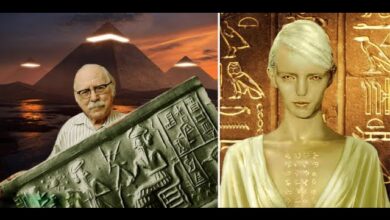Physics-Defying Ancient Desert TechnologyJust Discovered,It Changing Everything We Know About Water!
The ingenuity of ancient desert civilizations in managing water and creating thriving communities from harsh, arid landscapes is nothing short of remarkable. Recent discoveries have uncovered sophisticated technologies that helped transform desert environments into life-sustaining hubs, providing vital water supplies for agriculture and daily living. Despite extreme conditions, these civilizations developed techniques that continue to leave scientists in awe, offering innovative water management systems that defied nature’s limitations and allowed communities to thrive in the most inhospitable climates.
Across history, desert civilizations such as those in Egypt, the Indus Valley, and North America’s Southwest mastered the art of water management. In the face of minimal rainfall, high temperatures, and scarce vegetation, they constructed impressive infrastructures such as dams, canals, and water harvesting systems to collect, store, and distribute water. These advances enabled them to sustain agriculture, foster growing populations, and develop complex social systems.
Among these civilizations, the Persians stand out for their innovative water systems. In regions of modern-day Iran, the Persians developed extensive underground channels known as qanats, which tapped into groundwater to provide vital irrigation for crops. This system helped support large populations and made it possible to grow food in desert regions that would otherwise have been uninhabitable. One of the best examples of Persian ingenuity is the port city of Siraf, located on the Persian Gulf. Siraf’s advanced water management systems were originally misunderstood as burial sites; however, further research revealed that the thousands of holes carved into the rocky slopes above the city were part of a much larger network designed to harvest and store floodwater. These holes, combined with the qanat system, ensured that Siraf had a continuous and reliable water supply, even during dry seasons.
The Persian Empire’s engineering prowess went beyond water management. They also created a vast postal system, implemented efficient taxation methods, and developed early banking systems to keep the economy running smoothly. These advancements allowed Persia to thrive as a major political and cultural power, influencing neighboring civilizations through trade, technology, and cultural exchange.
The ability to adapt to the desert environment and find solutions to the challenge of water scarcity is a common theme across ancient desert civilizations. In the Americas, for example, the Maya developed chultuns, underground chambers used to collect rainwater, which helped them survive in regions with highly unpredictable rainfall. Despite the absence of major rivers, the Maya adapted to their environment with innovations that allowed them to continue growing food and sustaining daily life. Similarly, desert societies in the Sahara, such as those in ancient North Africa, relied on oases and underground reservoirs to support trade routes that connected Sub-Saharan Africa to the Mediterranean. These oases served as vital stopovers for caravans crossing the vast, inhospitable desert.
In modern times, the lessons learned from these ancient systems are more relevant than ever. Today, many regions of the world are grappling with water scarcity due to climate change, rapid population growth, and shrinking freshwater resources. The ancient methods of water management—such as qanats, infiltration basins, and rainwater harvesting—are being reexamined by contemporary engineers and urban planners as possible solutions to current water challenges. In fact, new technologies are helping make these systems more efficient and less labor-intensive, allowing them to be adapted for modern use.
One modern example of these ancient techniques being applied is the use of check dams. These small dams are designed to guide floodwaters into natural basins or underground storage tanks, mimicking the systems developed in ancient desert civilizations. This method not only prevents floods from damaging nearby settlements but also allows water to be stored and used later during dry periods. In the Middle East and Central Asia, engineers are also reviving the qanat system, using advanced drilling techniques to restore and build new qanats. These modern adaptations allow for more efficient water distribution, reduce evaporation, and minimize contamination, all while maintaining the basic principles of ancient water management.
What’s striking about ancient Persian cities like Siraf is their nature-based design philosophy. Rather than forcing nature to bend to human needs, these cities were built in harmony with the environment. This approach is in stark contrast to modern urbanization, where development often damages ecosystems in an attempt to control natural resources. By learning from the ancient wisdom of integrating environmental features into urban planning, contemporary societies can find more sustainable solutions to water management.
As urbanization spreads into arid desert regions, integrating traditional water systems into modern infrastructure projects could help create a more resilient and sustainable future. By studying how ancient Persian societies managed water through communal labor practices, inclusive governance, and shared responsibility, modern communities can learn how to reduce conflicts over water resources. Ancient Persia’s social systems, which encouraged cooperation and communal management of water, can be a model for today’s water-stressed regions, where disputes over water rights often lead to tensions between communities.
Ongoing research into Siraf’s ancient water systems continues to yield valuable insights into how these systems worked and how the city’s inhabitants adapted to their environment over time. Using advanced archaeological tools like ground-penetrating radar, researchers are uncovering hidden infrastructure and revealing the intricate network of water management systems that once supported Siraf’s thriving population. By analyzing soil samples, researchers are also gaining insights into the crops that were cultivated in the region and how the city’s water management systems evolved over centuries.
Despite the challenges posed by modern development, climate change, and tourism, efforts are being made to preserve Siraf’s ancient remains. Through careful restoration projects and responsible tourism practices, local economies can benefit from the site’s cultural and educational value while ensuring that its historical importance is preserved for future generations.
In conclusion, the water management systems of ancient civilizations like Siraf offer more than just historical lessons—they provide a blueprint for how modern societies can address the pressing issue of water scarcity. By integrating the wisdom of ancient cultures with modern technology, we can create sustainable water systems that help us navigate the challenges of a changing climate and growing populations. These systems, which once allowed ancient societies to thrive in harsh environments, may hold the key to ensuring water security for generations to come.








